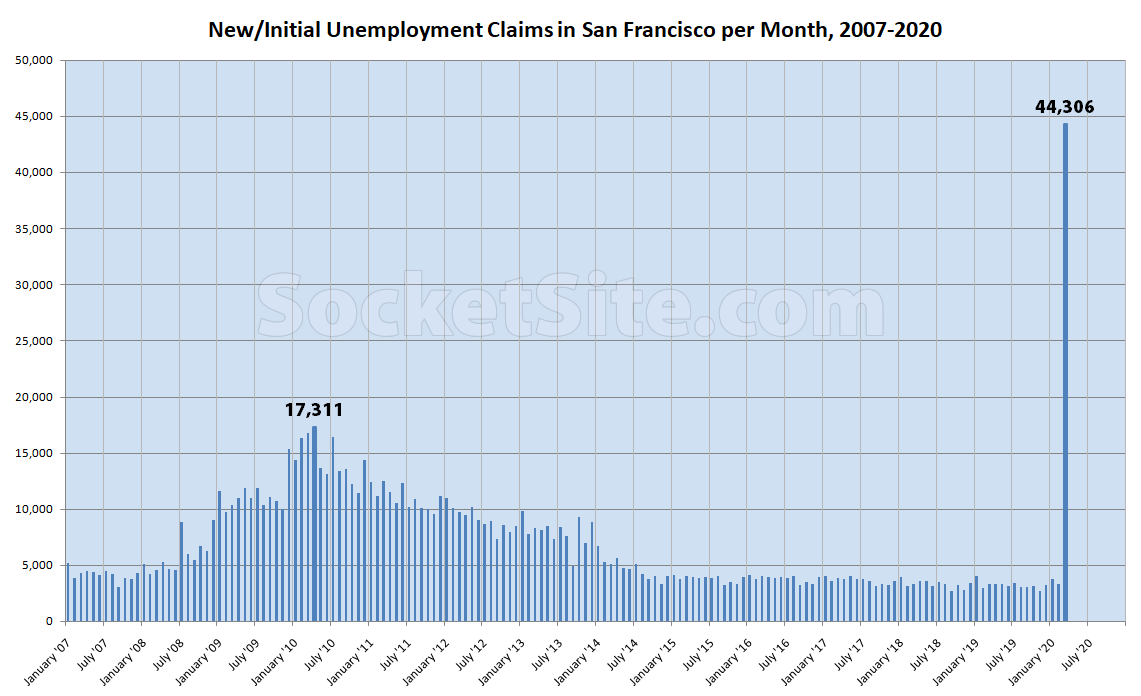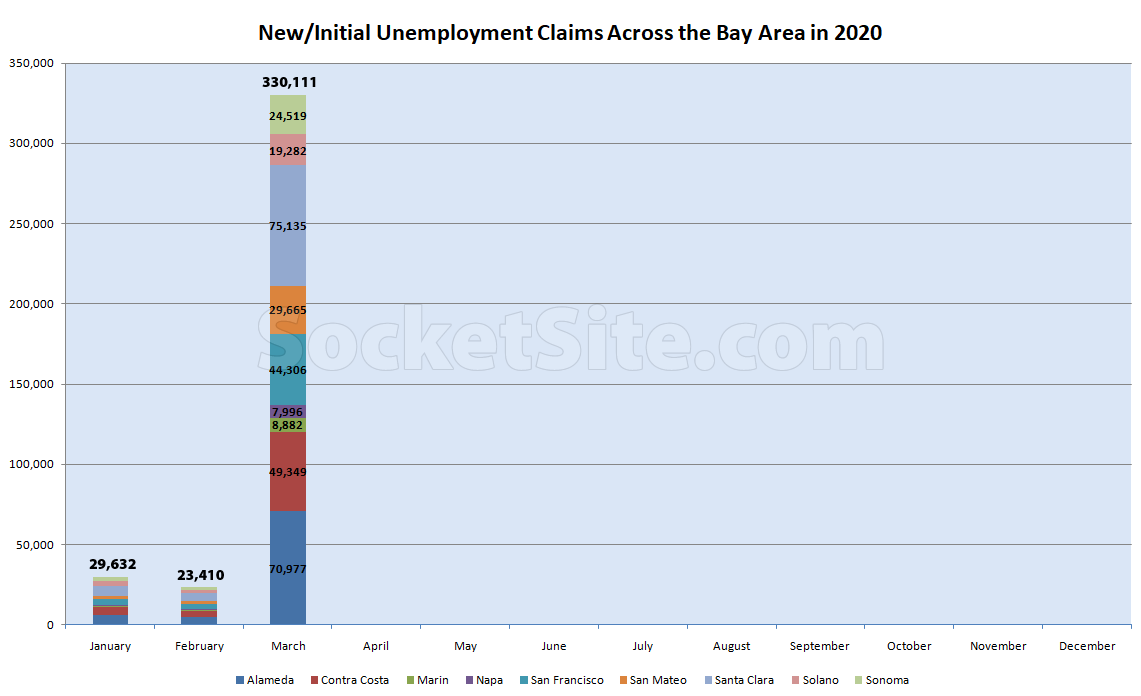Having averaged a little over 3,500 new claims a month over the past five years, and with a total of around 5,600 individuals in San Francisco having qualified to receive unemployment benefits in February, over 44,300 new/initial unemployment claims were filed by San Francisco residents in March.
As a point of comparison, at the height of the Great Recession, the greatest number of new unemployment claims filed in a single month was a little over 17,300 (April 2010), at which point there were a total of 29,000 people collecting unemployment insurance and 42,700 unemployed people in San Francisco overall.
And across the Bay Area, over 330,000 new unemployment claims were filed last month.
That’s over fourteen times the number of new unemployment claims that were filed across the Bay Area in February (23,400), with San Mateo County recording the biggest jump in new claims on a relative basis (from 1,751 new claims in February to 29,665 in March, up 1,694 percent) and Alameda Santa Clara County recording the biggest jump in new unemployment claims overall (from 4,909 in February to 75,135 in March, up 1,531 percent).
Keep in mind that none of the numbers above include claims from self-employed or contract/gig workers impacted by COVID-19 and whom can file for Pandemic Unemployment Assistance (PUA) as of today.


Similar to nationally which should come as no surprise – save for those who subscribe to the theory of San Francisco exceptionalism – altho it looks like the losses relative to ’08 aren’t as bad (or SF did relatively worse in ’08, to frame it in those terms).
But this too shall pass: Tesla is already planning reopening…production…the twitter department having never stopped (as it seems to be a ‘necessary minimal operation’ for them)
It might pass later than you think. “Per the direction of the executive leadership team, we will not be returning to work Wednesday, April 29. Please disregard all communication and directives on returning to work this week.” Looks like Gavin Newsom saw his shadow, so instead of the production line, it’s the unemployment line for 7500 Tesla employees, for at least another month.
As I said “planning”: the longer it’s drawn out, the more free publicity…and it’s not like a food processing plant in some flyover state: the world just can’t make it thru the summer w/o their Model S’ !!
The sky is actually falling and you’re all, “Just one more well placed barb and bang, pow, kazoom … nuclear winter, bitches. Cormac McCarthy eat your heart out.” You didn’t buy in 2010, did you? You won’t in 2022 either.
Are you implying 2022 will be the low? Interested in hearing a range of opinions out there.
Like everything this too will pass. However, the tourist industry and its ancillary industries such as restaurants will be a long time recovering. A good chunk of the restaurants will not reopen. Independent retail will not come back. All those empty storefronts before the pandemic? They will be joined by many new such. Telework, Zoom – there will, some argue, be a shift from densely packed offices to a more spread out workforce. Regionally but even broader than that. The shelter in place situation is making some people realize how confining living in a small SF apartment or a ticky tack box with virtually no backyard really is. Many real estate folk are expecting an accelerated exodus from highly dense cities such as NY, Chicago and SF to not just the burbs but the exurbs. As a friend said recently – I want a man in my life, just not in my house. That after being confined with her husband in a small apartment for a month.
The knee-jerk wisdom of 9/11 was that no one would want to work in, let alone build, tall buildings again. It was deemed the end of the super high rise. Yet it was not remotely true, at all. Pretty much all of the world’s tallest buildings have been built since then, including several buildings in SF that eclipse the then-tallest buildings in the City. The same will be the case by this knee-jerk declarations of the vice and undesirability of density.
There has been two pandemics of this scale in the past 100 years. Yes, there will be more in the future, but once this settles out SF and other cities will come roaring back, because all things being equal, it is a far more sustainable, economically dynamic, and socially interesting way of living. In fact, what the current pandemic has proven is that vulnerability has nothing to do with density and everything to do with effective government and sufficient public health infrastructure. Point in case, SF per capita fatality rate is one quarter that of Los Angeles.
My relatives in LA, with their large houses and backyards, are far more cooped up than we here in SF, because at least we can walk to parks, the ocean, the bay, and such from our homes. They have nothing within walking distance (and actually lack sidewalks in their area), have to drive, and are forbidden from driving that far.
hmmm, indeed. The various pitfalls – and attractiveness – of density were discussed here earlier, but we should all strive to start from the same correct base of info: for all of its reputation of sprawl, parts of LA are quite dense…and, perhaps not surprisingly, it’s those very parts that have the worst rates. So, no density isn’t necessarily bad; but nor is it necessarily good either.
Whether SF governments is “effective” is up for debate, that it started with a lot of money is not.
The infection and mortality rates seem more geographically correlated with income than density. Again case in point: the SF zip code for Chinatotwn, North Beach, and Russian Hill, which is among the densest if not the densest zip code in the city, has near the lowest infection rate. Bayview, the least dense, has near the highest rate.
SF government was pretty much the first to make the bold order to SIP and not dithering around, and has mobilized an impressive emergency response effort to prep for a surge of hospitalization.
SF did well in this – tho as your link indicates, the “bold(ness” was more of a Bay Area effort – I’m not questioning that; I was referring more to their general history of dealing with issues: homelessness, pension funding, general efficiency in spending; to judge by the comments on these pages, one might think nothing is done right; and while the commentariat here is often in-expert, it’s fair to say when you have lot’s of money to spend, you don’t have to worry much about spending it wisely. If the former should change, will the latter respond…hmmm??
One aspect of “dense” living that may come out of this poorly – both figuratively and literally – is public transit: couldn’t your correlation map also equate to inbound ride times ?? In New York, the highest rates – at least initally – were in the outer boroughs; is it possible there was a correlation b/w subway useage/ride time and rates?? Something to look at (and we have plenty of time on our hands right now)
You’re conflating population density with income and wealth. People in the Bayview are getting sick because they can’t SIP and have to get out to work. If they can’t work, they’re in financial ruin. This is why they have higher contagion rates. Has zero to do with density don’t play that card.
The Chads and Beckys in Russian and Nob Hill can sit around and take Zoom meetings all day long while still getting paid. These are two very different groups. Two weeks ago, HPBayview you saw masks everywhere. Russian Hill Polk Street looked like a an outdoor holiday festival. People hanging out while collecting 6-7 figure salaries and not a mask in sight except the postman.
We’ll see. Just today Barclay’s asks will companies continue to cram thousands of people into office towers?
There’s no way I’m getting an an office high rise elevator until there’s a vaccine. Sorry, you can yell sustainability until you’re blue in the face. Most could care less. The stuff has hit the fan and commercial real estate is effed. Without the need for that big office, many will leave.
Really? Lets keep spreading bad news- its great for everyone’s morale.
looks like uber is making major cuts as well.
Interesting the claim that 5400 layoffs would “save about $1B/year”
which would imply the laid off average just south of $200k/year;
I would think they would lay off the least valuable, and I find it hard to believe
the ‘least valuable’ make that…even at Uber.
Other possibilities, of course, are that this is only part of the savings..or that the Chron’s miserable proofreading struck again.
$200k is the fully loaded cost including benefits, resources used, office space, etc. Generally you divide by 1.6 to get the salary, which would be $125k in this case. I think that is perfectly reasonable, especially since there are Silicon Valley companies with median salaries that are over $200k (including Google and Facebook). Splunk is the highest at $260k I believe ($416k fully loaded). Insane right?
The $200K is the cost the company and only a part of that is salary. The rest of it is health benefits and other related overhead.
The cost of an employee is always more than their salary
Thanks; yes, I’m aware that the loaded/full cost is greater than the actual W-2 number – in addition to writing pithy comments on blogs I do finance…but only for a living – but I would point out:
(1) you’re not going to save overhead in laying people off if it includes things like “space costs”; and
(2) while the mean – or even the median – might be in this range, I’m doubtful the LOWEST are in it…and my whole premise is that the lowest are the most likely to be laid off. Of course I could be wrong, and they’re simply laying off – say – 5 of 100 identical programmers. And finally,
(3) Yes, ‘Splunk’ is insane…in every aspect from the name on down.
lyft laying off 17%, furloughing more, paycuts for others.
“Juul Labs Plans to Cut Roughly a Third of Its Workers” (between 800 and 950 in SF)
UPDATE: While new unemployment claims in Alameda County jumped from 5,130 in February to 70,977 in March, which was up 1,384 percent, the Bay Area county with the biggest jump in new unemployment claims in the absolute was actually Santa Clara County (from 4,909 in February to 75,135 in March, up 1,531 percent), as since corrected and newly charted above.
Google estimates SF’s resident work force at 490,000. 44,300 ui claims. Around 1 out of 10. Seems higher? Guessing economists have a method for adjusting unemployment rate to include those that don’t (usually) qualify, like part-times, artists, etc etc. 1 out of 5 in SF at the moment?
The size of the Labor Force in San Francisco is actually closer to 580,000 (or at least it was in mid-March, at which point the unemployment rate was 3.0 percent with around 18,000 unemployed residents, only a fifth of which had a qualifying/active unemployment claim).